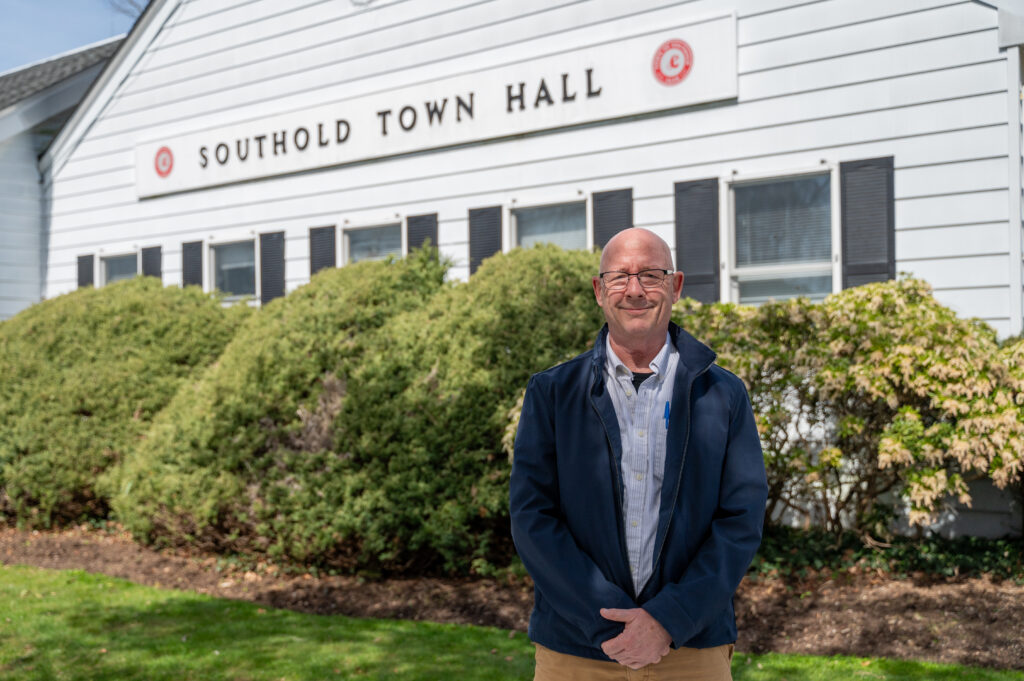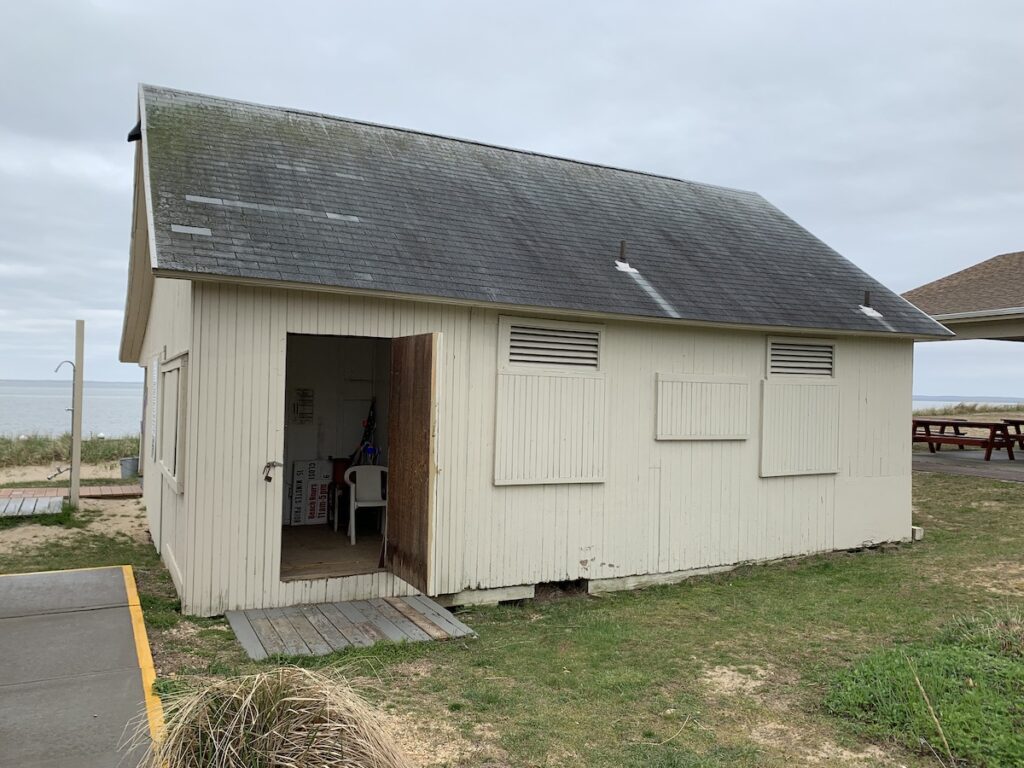Cutchogue winemaker reconstructs 18th century barn as a monument to North Fork preservation

On a hilltop at the center of more than 200 acres of preserved land that stretches almost shore-to-shore in Cutchogue, winemaker and preservationist Russ McCall is near completion of an awe-inspiring project: reconstructing an 18th century New Hampshire barn without the use of a single nail or screw.
In the final weeks of the marathon endeavor, Mr. McCall agreed to give The Suffolk Times a tour of the nearly completed historic barn and talk about the years-long journey that began with an unexpected call from an historic barn expert. Originally built in New Hampshire during the Revolutionary War era, the reconstruction is expected to be completed this month. Mr. McCall said the barn is the physical embodiment of his commitment to preservation.
“Part of putting your foot in the ground and saying, ‘I stand for preservation on the North Fork’ is the fact that we can establish a few-hundred-years-old barn and keep it in its original state and keep it as a monument to preservation.”
For decades, Mr. McCall and his wife, Nicola, have been buying up land surrounding their vineyard, which abuts Downs Farm Preserve bird sanctuary and wildlife refuge, to protect it for future generations. The McCalls also preserved Downs Woods, once the cultural center of the Corchaug Indian tribe — one of numerous tribes that made up the Algonquin Indians — as well as property bordering their vineyard that was going to be sold to developers and a vineyard across Route 25.
“So that’s kind of the sense behind this [barn] project,” Mr. McCall said. “It’s not just the barn. It’s the [Corchaug] Indian site. It’s the land that goes out to Peconic Bay, it’s the salt air and the bird sanctuary and the marsh out there that’s preserved. With all the adjoining sites, we have over 200 acres that’s preserved forever.”
‘Spectacular’
About eight years ago, Mr. McCall was contacted by an historic barn expert with whom he had previously worked. A barn in Loudon, NH, built in the 1700s, was set to be torn down after the land beneath it was sold.
“The town was closing in on what had been an old farm, and this [barn] had become the town center,” Mr. McCall said. “So, the farm was gone, but the barn was still there, and there were some heirs who didn’t care about it. They just wanted to get some money out of the wood, so they were going to sell it off.
“It’s been sitting there since before George Washington became president,” he added. “I mean, it was made before we even had a Constitution. I had to go up and see it.”
When he finally laid eyes on the barn, he was captivated.
“It was spectacular,” he said.

Mr. McCall, whose family has been living on the land that now makes up the vineyard since 1902, said safety and environmental regulations forced him to rethink how to balance modern building requirements with the historic integrity of a barn older than the United States.
“It was relatively cheap to buy,” he said. “I wasn’t thinking about what it would cost to put it back up.”
Patient and undaunted, Mr. McCall pressed ahead.
“I hired an engineer who knew about old barns. I hired some guys in their 70s who had been putting up and taking down barns for years, so they knew what they were doing. They came down from Massachusetts. The barn [wood] was here in three old containers just to store it — plus a truck full of the original stone and granite.”
Three years ago, Mr. McCall brought on Southold architect Clay Coffey of the Greenport-based architectural firm Isaac-Rae and a trusted engineer who mapped out plans for the reconstruction, and last year the re-assembly of the structure began in earnest.

No nails, no screws
Faithful to its original form, the barn features a cedar, slip-sheath shingle roof and a reconstructed cupola that looks just like it did in the 1700s, right down to the white and green paint. The barn’s original siding lines the interior walls. To reinforce the aged wood, ¾-inch plywood was added discreetly and hidden beneath wooden boarding.
“So, the wall is actually three generations of wood, for structure,” he said.
Other necessary modern elements include a fire suppression system — a series of pipes that snake through the interior of the walls towards sprinklers hidden in the ceiling..
Mr. McCall said that the barn’s eight trusses — stabilizing beams that line the interior of the ceiling, are all original.
“We needed an original, 40-foot, 200-year-old piece of lumber, that fit on top of the mortise and tenon,” he said, referring to a joint that fits two pieces of wood together.
“You’ll never see a nail in this structure,” he said. “That is the way it was originally, and I wanted to preserve that.”
To reinforce the aged trusses, he layered the inside of the roof with 9-by-7 inch pieces of wood known as strong backs.
“If you look at the braces all around, each one of those braces slips into a slot in the wood. They’re not nailed. Every one of those braces has a piece of dowel in it so there’s no nails or screws,” he said. “It was put together in pieces, exactly as it came down.”
Mr. McCall made a point to note that since 2019, Mr. Coffey has been “instrumental in planning, permitting and executing the barn restoration project.”
Wine Cellar
Mr. McCall also built a subterranean wine cellar and production facility beneath the barn with floor drains for winemaking. By storing wine underground, he said, “you don’t have to pay a lot for AC and heating.
“For wine, you need 56 to 58 degrees for year-round storage. This took time to pour the [concrete] foundation and make it the right humidity and temperature.”
The barn’s ground-level entrance features a distinctive archway fashioned from repurposed granite columns that once supported the structure in New Hampshire.

Asked how much the entire endeavor cost, Mr. McCall winced, then smiled, and said it was well worth the expense.
“The purchase of the old barn was probably $25,000 to 35,000, which was just for the pieces, but then the three containers to store it in and keep it out of the rain, cost $20,000. So, then it was in New Hampshire and I had to bring it down here. It’s over a million dollars to re-erect it. I didn’t know that when I was getting into it. I budgeted it for about half of what it was, but it was over a million.”
Which is fine with Mr. McCall.
“This is what preservation is,” he said. “You take your time, you have a long term plan, and you make it work.”








